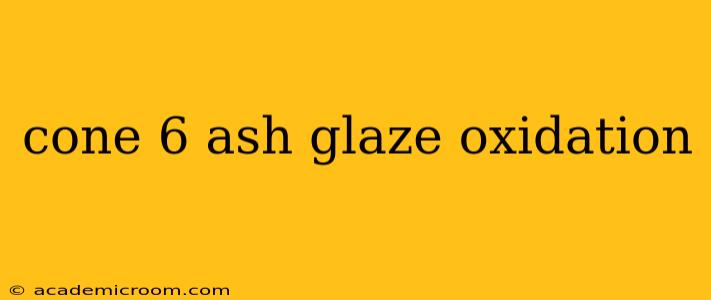Cone 6 ash glazes, fired in oxidation, offer a captivating range of aesthetic possibilities for ceramic artists. Their unique characteristics, stemming from the natural variations in ash composition and the oxidizing firing environment, create glazes with depth, texture, and a subtle beauty that's hard to replicate with commercially produced glazes. This comprehensive guide delves into the nuances of cone 6 ash glazes fired in oxidation, exploring their properties, formulation, and the secrets to achieving stunning results.
What is a Cone 6 Ash Glaze?
A cone 6 ash glaze is a ceramic glaze primarily composed of wood ash, often supplemented with other materials to adjust its properties. "Cone 6" refers to the firing temperature (approximately 2232°F or 1222°C), a high-temperature firing crucial for ash glazes to fully mature and develop their characteristic features. The "oxidation" aspect signifies that the firing process occurs in a kiln with ample oxygen, influencing the glaze's color and overall appearance. The beauty of ash glazes lies in their inherent variability; each batch, and even each piece within a single firing, will exhibit unique characteristics reflecting the subtle variations in ash composition.
What are the Advantages of Using Ash Glazes?
Ash glazes offer several key advantages over commercially produced glazes:
- Unique Aesthetics: The unpredictable nature of ash glazes leads to one-of-a-kind results, each piece bearing its own distinctive character. This is highly sought after by artists who value originality and handmade qualities.
- Sustainability: Utilizing wood ash as a primary ingredient aligns with sustainable practices, reducing reliance on commercially mined materials.
- Connection to the Environment: Ash glazes offer a direct connection to the environment, reflecting the character of the wood source used to produce the ash.
- Cost-Effectiveness: Sourcing ash locally can be significantly more affordable than purchasing commercial glazes, particularly for artists working on a larger scale.
How Do I Make a Cone 6 Ash Glaze?
Formulating a cone 6 ash glaze involves several steps and considerations:
- Ash Source: The type of wood significantly influences the glaze's properties. Hardwoods generally produce higher-alkali ash, while softwoods yield lower-alkali ash. Experimentation with different wood ashes is key to understanding their impact.
- Testing: Thorough testing is crucial to determine the optimal proportions of ash and other additives. Test tiles fired to cone 6 are essential for evaluating the glaze's maturity, color, and surface texture.
- Additives: Other materials such as feldspar, silica, and whiting are often added to adjust the glaze's fluidity, melting point, and overall properties. These additions refine the raw ash and enhance its performance.
- Sifting: Thoroughly sifting the ash is crucial to remove any large particles that could cause imperfections in the finished glaze.
What are the Challenges of Using Ash Glazes?
While ash glazes offer numerous benefits, they also present some challenges:
- Variability: The unpredictable nature of ash glazes can be both a blessing and a curse. Achieving consistent results requires careful testing and understanding of the ash's properties.
- Testing: Extensive testing is required to perfect a recipe and achieve desired results. This is time-consuming and requires patience.
- Safety: Ash handling requires appropriate safety measures to avoid inhalation of fine ash particles.
What are the Different Colors Achievable with Cone 6 Ash Glazes in Oxidation?
The color palette achievable with cone 6 ash glazes in oxidation is diverse and depends heavily on the ash source and any added materials. Expect to see a range of earthy tones, including:
- Creamy Whites and Beiges: Often achieved with softer wood ashes or with added whiting.
- Warm Browns and Tans: Common with hardwood ashes.
- Subtle Greens and Greys: Can result from the interaction of the ash with other minerals in the glaze or the clay body.
- Speckled or Mottled Effects: These are often inherent in the nature of ash glazes, adding to their unique charm.
How Does the Oxidation Firing Affect the Glaze?
Oxidation firing, characterized by ample oxygen supply during firing, plays a crucial role in the final appearance of the glaze. In an oxidizing atmosphere, the glaze will develop its full color potential and achieve a bright, even finish. The presence of oxygen allows for complete combustion of organic materials and promotes the formation of stable crystalline structures, leading to a more robust and durable glaze.
What are Some Tips for Success with Cone 6 Ash Glazes in Oxidation?
- Start Small: Begin with small test batches to experiment with different ash types and recipes.
- Document Everything: Meticulously record your recipes and observations to track your progress and refine your technique.
- Patience is Key: Mastering ash glazes takes time and dedication. Don't be discouraged by initial inconsistencies.
- Embrace the Unexpected: The unique beauty of ash glazes lies in their variability. Learn to embrace the unexpected results.
By understanding the properties of cone 6 ash glazes and the influence of oxidation firing, ceramic artists can unlock a world of creative possibilities. The journey of exploring these natural glazes is a rewarding one, leading to unique and captivating results that reflect the artist's connection to the earth and their creative process.
